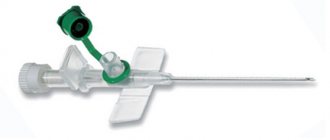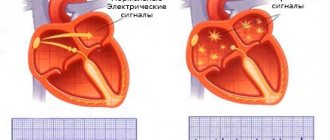Buy a venous catheter:
- Intravenous catheter with additional port | Vogt Medical, Germany (VM) from RUB 10.90
- Intravenous catheter for newborns and children under 3 years old | Vogt Medical Vertrieb GmbH, Germany from RUB 12.00
- Intravenous catheter with additional port | Manufacturer: India from 8.50 rub.
- Intravenous catheter with additional port and fixing wings | " BEROCAN", Germany ("Beromed")
- Peripheral venous catheter with protective clip and additional port with wings | POLY SAFETY, FEP material (Teflon), India
- Peripheral venous catheter with protective clip and additional port with wings | POLY SAFETY, material PUR (Polyurethane), India
An intravenous (peripheral) catheter is a medical device intended for long-term administration of drugs into peripheral veins (up to 3 days) or removal of liquids, solutions of drugs from the human circulatory system using a catheter inserted into a blood vessel (patient’s peripheral veins) with in order to reduce injury to the vein using a hollow needle (introducer). The needle is removed immediately after the catheter is inserted into the vein. Peripheral venous catheter (catheter into a vein) - inserted into the arm, neck or head. The other end of the catheter is free, through which the necessary drug is administered. Often, an intravenous catheter is used in cancer patients who need to administer drugs intravenously for a long time, for example, chemotherapy drugs, as well as nutritional solutions, blood products, and others. Venous catheters are distinguished by the material of manufacture (Teflon or PUR), which is Teflon (Teflon) - elastic with a smooth surface for standard cases with a catheterization period of 24-48 hours. Venous catheters, India (ie “OneFlon”) are made of polytetrafluoroethylene material. PUR (Polyurethane) is a softer and thermoplastic material, designed for more complex veins and longer catheterizations within 48-72 hours. The VEIN CATHETER is manufactured using modern technology for the production of catheters without the use of latex - this guarantees that there is no risk of developing allergic reactions to latex. Placement of a venous catheter into a vein using the “on a needle” method has features: the tip of the catheter has a smooth cone-shaped narrowing, and the guide needle has a special tip geometry (triangular sharpening with a reverse side cut and special grinding of the needle), a minimum distance from the end of the catheter to the bevel of the needle and a reduction The thickness of the catheter wall towards the distal end provides optimal conditions for puncture of the vessel (vein). The reverse blood flow chamber of the venous catheter provides reliable control of the positioning of the needle in the vein and allows you to quickly determine the success of venipuncture.
Special “wings” of the peripheral venous catheter allow you to securely fix the catheter on the patient’s skin, thereby significantly reducing the risk of mechanical damage to the inner wall of the vessel and the development of mechanical phlebitis. The thin-walled design of the catheter tube allows for maximum infusion rates with a minimum catheter diameter. The peripheral intravenous catheter with an additional port has an injection port for bolus administration of medications and flushing of the catheter, which makes it possible to administer medications during the infusion process.
Catheter wings allow secure fixation of the catheter and eliminate the possibility of unauthorized removal; The venous catheter case reliably protects the needle and catheter from damage. The radiopaque tubing of the venous catheter provides an additional degree of safety by allowing monitoring of the distal tip of the catheter in the event of damage. The venous catheter is internationally color coded for the size of the catheter.
Where are catheters used?
Catheters are often used by laboratory technicians who draw blood from a vein. If the doctor has given you a referral for several different types of blood tests, each of which requires filling a separate container, it is more convenient to collect it through a catheter. Such devices are called butterflies. They are distinguished by colors, each of which has a needle of a certain diameter and length. The catheters got their name from the external resemblance of the retaining petals to the wings of a butterfly.
In urology, another type of catheter is used, which is a long tube. It looks like a gel pen refill. Such a device is inserted into the urinary canal and inserted until one end of the tube is in the bladder. This type of catheter is used in the treatment of bladder inflammation, including cystitis, when it is necessary to introduce the active substance of the solution directly into the bladder cavity.
Obstetricians resort to catheterization when a postpartum woman cannot urinate on her own due to a pinched urethra or dysfunction of the urinary sphincter. In this case, a catheter is also inserted into the bladder, through which urine exits into the vessel.
In ENT practice, nasal catheters are used. They are also flexible, hollow tubes through which the doctor can rinse the sinuses or remove pus and mucus from the maxillary sinuses.
Separately, there are cardiac catheters, which are used as a tunnel to carry wires to a heart pump or implant.
Peripheral venous catheter Vogt Medical, Germany (VM)
The VM peripheral venous catheter is used for catheterization of peripheral veins in patients requiring long-term infusion therapy. They are designed for catheterization of peripheral veins for the purpose of long-term infusion therapy; a special catheter profile, as well as triangular sharpening of the guide needle, provide optimal conditions for puncture of the vessel. The cannula is made of thermoplastic and biocompatible material, which is ideal for long-term catheterization, and the radiopacity of the cannula material allows you to control its position. The wings provide comfortable grip during manipulation and reliable fixation of the cannula, thereby eliminating the possibility of accidental removal. Reverse blood flow chamber
allows you to quickly determine the success of venipuncture. The thin-walled design of the tube allows for maximum infusion rate with a minimum cannula diameter. Needle: special stainless steel with a high content of chromium and nickel in accordance with the AISI standard. Catheter: polyurethane/polytetrafluoroethylene. Packaging: blister/box 100 pcs. / box 1000 pcs. Quality: in accordance with ISO 10555 Sterilization: ethylene oxide Shelf life: 5 years
| Catheter size, (G), length, (inch) | Catheter outer diameter x length, mm | Color code | Flow rate, ml/min |
| 14G – 1 3/4 | 2.1 x 45 mm | orange | 270 |
| 16G – 1 3/4 | 1.8 x 45 mm | grey | 200 |
| 17G – 1 3/4 | 1.5 x 45 mm | white | 140 |
| 18G – 1 3/4 | 1.3 x 45 mm | green | 85 |
| 20G – 1 1/4 | 1.1 x 32 mm | pink | 55 |
| 22G – 1” | 0.9 x 25 mm | blue | 33 |
| 24G – 3/4 | 0.7 x 19 mm | yellow | 18 |
| 26G – 3/4 | 0.6 x 19 mm | violet | 10 |
Intravenous catheter (peripheral) with additional port of the river G17-22 - price: 10.90 rub. Intravenous catheter (peripheral) with additional port of the river G14, 16 and G24 - price: 11.50 rub. Intravenous catheter (peripheral) with additional port of the river G26 — — price: 11.90 rub. , Germany “Beromed GmbH Hospital Products”, Germany (TM “BEROCAN”) Analogues: Vasofix Braunula / Intravenous cannulas with injection port “Vasofix”
PEDIATRIC CANNULES WITH SMALL WINGS AND INSERTION DEVICE for newborns and small children
Needle (Stainless steel)- Cannula (Fluoroethylenepropylene/polyurethane)
- Cannula holder (Polyoxymethylene)
- Wing body (Polypropylene)
- Needle hub (Polypropylene)
- Needle gripper (Polypropylene)
- Luer Lock Cover (High Density Polyethylene)
- Needle cover (Polypropylene)
- Device for inserting a catheter into a vein (Polypropylene).
Intended use: Catheterization of peripheral veins (thin and fragile vessels) in newborns and small children under 3 years of age is an effective method of providing reliable access to the child’s venous system. For young children, special catheters have been developed and used, which are recommended for use in neonatology, pediatrics and geriatrics. The removable false port system (a device for inserting a catheter into a vein) makes it possible to use the usual grasping technique when inserting a catheter. Once the catheter is inserted, small flexible wings are released to ensure a secure fit even on a newborn's arm. The use of peripheral venous cannulas (IV cannulas) in neonatology and pediatrics significantly reduces the number of complications and improves the quality of treatment, ensures motor activity and comfort for the child and minimizes the psychological burden on relatives. Main advantages: The pediatric pediatric venous catheter (IV cannula) has a special user-friendly design for use in neonatology and pediatrics. The best geometry of the needle tip with a Buck Cut cut (special sharpening) The catheter has 4 radiopaque stripes Made from PU (polyurethane has a “memory effect”) or FEP (fluoroethylenepropylene) High biocompatibility and thromboresistance Does not contain latex Available sizes: G24 and G26 European quality: meets CE and ISO standards
| Catalog no. | X-ray contrast stripes | Size | Length in mm | Wings | Flow rate | Code color | Quantity per pack |
| IV PEDIATRIC CANNULES WITH SMALL WINGS AND INTRODUCTION DEVICE | |||||||
| 1311702H | 4 | 24G | 19 | small | 18 ml/min | yellow | 100/1000 |
| 1311703H | 4 | 26G | 19 | small | 10 ml/min | violet | 100/1000 |
Quality and safety: Standard: ISO 10555-1.5 Sterilization: Ethylene Oxide Shelf life: 5 years. Packaging: Blister packaging / 100 pcs per pack. 1000 pcs. in cor. , Germany Price: 12.00 rub. Analogues: " BD Neoflon", B.Braun "Vasofix"
Features of catheterization
Regardless of the type and reason for use, all catheters require mandatory fixation. The tube is secured to the skin using medical tape or suture material. Modern models are initially equipped with special clamps, which greatly facilitates the catheterization process. Additionally, it is necessary to set the position of the tube inside the cavity; most often, the instrument has a device that allows you to quickly change its shape after insertion into the hollow organ.
The most widely used system is the Pigtail system - the tip of the catheter made of polyvinyl material looks very similar to a pig's tail, hence the name. During production, this device is placed in a special stylet or conductor, and after installation it is released and, twisting, prevents the tube from falling out of the organ. This type of fixation system is recognized as the safest and easiest to implement.
For a more rigid fixation, a loop is used, which is tightened with a fishing line previously placed in the catheter cavity.
Intravenous catheter with additional port made in India
Intravenous catheters are intended for catheterization of peripheral veins for the purpose of long-term or short-term infusion-transfusion therapy. Material: polypropylene, medical steel, Teflon, polyacetal, high-density polyethylene, low-density polyethylene, silicone.
Intravenous catheter Polyflon or SoftCathe transparent intravenous catheter made of Teflon, central hole with atraumatic edges; four x-ray positive strips along the entire length of the catheter; pavilion with a luer-lock port for connecting an infusion line or syringe; bending wings. An additional port for instant injections with a non-return petal valve is located at the top of the catheter; Equipped with a standard Luer-lock connector.
Unified color coding of the catheter size “SoftCathe”
| Catheter size, (G) | Catheter outer diameter, mm (OD) | Int. catheter diameter, mm (ID) | Color code | Length, mm | Flow rate, ml/min |
| 14G | 2,0 | 1,7 | orange | 45 | 305 |
| 16G | 1,7 | 1,3 | grey | 45 | 200 |
| 17G | 1,5 | 1,1 | white | 45 | 142 |
| 18G | 1,3 | 0,9 | green | 45 | 95 |
| 20G | 1,1 | 0,8 | pink | 32 | 65 |
| 22G | 0,9 | 0,6 | blue | 25 | 36 |
| 24G | 0,7 | 0,5 | yellow | 19 | 23 |
Stiletto needle with a triangular oblique cut; transparent needle pavilion with a Luer-lock connector, equipped with two grooves for fixing the stylet with the catheter pavilion, finger rest; removable translucent plug on the Luer-lock connector.
An additional luer-lock plug made of opaque white plastic with a faceted outer surface is fixed on the needle pavilion plug. The catheter is closed with a protective transparent cap. Sterilization: individual blister packaging. Sterilization using ethylene oxide. Shelf life: 5 years.
, India (TM "SoftCathe" or "OneFlon") Global Medikit Limited, India (TM "Mediflon") Harsoria Healthcare Pvt. Ltd” , India (tm. “HEALFLON”) “La-med Healthcare Pvt. Ltd" , India (TM "La-med IV cannula") "SURU International PVT.LTD" , India (TM "SURUFLON") "Poly Medicure Limited" , India (TM "POLYFLON FEP" ") "Interpharma" , India (t.m. "EUROFLON")
Intravenous catheter (peripheral) with additional port of the river G16-22, price: 8.50 rub. Intravenous catheter (peripheral) with additional port of the river G 24, price: 9.50 rub. Intravenous catheter (peripheral) with additional port of the river G14 and G26, price: 11.50 rub.
INTRAVENOUS CATHETERS “Beromed” FOR PERIPHERAL VEINS with an additional port and fixing wings
Intravenous catheters “BEROMED” for peripheral veins with an additional port and fixing wings are used for long-term intravenous infusions. Specifications:
- The puncture needle is made of high-quality, thinnest surgical steel, which allows it to maintain strength with minimal wall thickness
- triple sharpening of the needle ensures atraumatic insertion
- the elastic surface of the catheter allows painless insertion of the catheter into the vein
- two built-in radiopaque strips
- integrated injection port "Luer" / "Luer-Lock" type "male" with non-return valve
- fixing wings allow you to securely secure the catheter
- color coding of the additional port plug allows you to visually determine the size of the catheter
- hydrophobic catheter plug prevents blood leakage, removable plug for quick closure of the catheter
- catheter material FEP (fluoroethylpropylene), sizes G 14, 16, 17, 18, 20, 22, 24, 26
- the entire product is made of materials with a high degree of biotolerance, sterile, pyrogen-free, non-toxic
- Individual packaging, easy to open, contains all the necessary information about the product.
Intravenous catheter with additional port “Beromed”, Germany
| Catheter size, (G), length, (inch) | Catheter outer diameter x length, mm | Color code | Flow rate, ml/min FEP | Flow rate, ml/min PUR |
| 14G – 1 3/4 | 2.1 x 45 mm | orange | 305 | 305 |
| 16G – 1 3/4 | 1.7 x 45 mm | grey | 200 | 200 |
| 17G – 1 3/4 | 1.5 x 45 mm | white | 142 | 142 |
| 18G – 1 3/4 | 1.3 x 45 mm | green | 95 | 95 |
| 20G – 1 1/4 | 1.1 x 32 mm | pink | 60 | 60 |
| 22G – 1” | 0.9 x 25 mm | blue | 36 | 36 |
| 24G – 3/4 | 0.7 x 19 mm | yellow | 23 | 23 |
| 26G – 3/4 | 0.62 x 19 mm | violet | 17 | 17 |
, Germany (t.m. “BEROCAN”) Venous catheter with additional port + wings, river. G 16-24, price: 10.90 rub. Venous catheter with additional port + wings, r. G 14-26, price: 11.50 rub.
Peripheral venous catheter with a protective clip and an additional port with POLY SAFETY wings, FEP material (Teflon)
The peripheral intravenous catheter, equipped with a self-locking device (Safety type) is a disposable sterile peripheral intravenous catheter on a sterile stainless steel needle, intended for puncture and catheterization of peripheral veins, equipped with a device for blocking the needle tip in the form of a bullet-shaped clip that is self-installed during reverse traction (when removed needles from the catheter). disposable venous catheter - has a device (hydrophobic plug) that blocks the needle tip with a plastic clip during the completion of the traction movement when removing the needle from
catheter installed in a vein. This prevents attempts to reuse the catheter, as well as to advance the needle into the catheter if installation is unsuccessful (the possibility of cutting off the catheter with the needle tip when attempting to advance again is eliminated). Safety catheter composition: Manufacturing materials: FEP (Teflon) or PUR (Polyurethane) , the catheter has 4 (FEP) and 6 (PUR) fully built-in radiopaque strips, an additional infusion port with a tight, quick-release, harness-fixed, sealed cap, wings , Luer-Lock plug, puncture needle is made of stainless steel with an additional Luer-Lock plug made of opaque white plastic with a faceted outer surface, fixed on the needle pavilion plug. International color coding for catheter cap. Does not contain Latex (LATEX FREE) Safety FEP (G) catheter sizes: 14, 16, 18, 20, 22, 24, 26, 27 Packaging: Individual, sterile, Tyvek blister, multiples of 100 pcs. Sterilization: ethylene oxide. Shelf life: 5 years. Brand and , India
Price: Intravenous catheter with a protective device “POLYSAFETY” material FEP (Teflon) r. G 16-22, price: 45.00 rub. Intravenous catheter with protective device “POLYSAFETY” material FEP (Teflon) p. G 24, price: 47.00 rub. Intravenous catheter with protective device “POLYSAFETY” material FEP (Teflon) p. G 26, price: 50.00 rub.
Foley catheter for the bladder: how to place it
When choosing a specific catheter model, it is important to take into account the main indications, the expected duration of catheterization, and the age of the patient. The doctor will tell you how to determine the size and type of the product: the diameter of the tube is determined by the size of the urethra, where the catheter is inserted to pass it into the bladder cavity. The dimensions of the external part can be from 2.7 to 8.7 mm, and the internal ones from 1.7 to 6.9 mm.
An equally important question is how often catheters are changed. If it is latex, it can last up to 7 days, silicone catheter up to 30 days. Next, the doctor determines what to lubricate the tip with before insertion. These are usually sterile aqueous lubricants, as well as pre-immersion in saline.
Materials for production
The first medical catheters were made of durable materials - latex, elastomer or silicone rubber. They were inflexible and intended to be used over and over again. Gradually, other substances were replaced by silicone. The main advantage of this material is that it does not react with biological fluids. But there are also significant drawbacks - it is quite fragile, and in some cases small particles of the tube can remain inside the body, causing various complications.
Depending on the characteristics of the material used, all modern catheters are divided into soft and hard. The first ones are made of a special composition of rubber or polyvinyl chloride and can be used for both medicinal and surgical purposes.
The material for the manufacture of rigid catheters is metal. These tools are intended for the implementation of diagnostic measures.
For example, if a microcamera needs to be inserted into the stomach to visualize the state of its walls and mucous membrane, then the sensor is inserted using a metal tube. Modern catheters, made of high-quality polymer material that is safe and hypoallergenic, can be disposable or reusable.
Classification
Depending on the area of use, the following types of catheters are distinguished:
- aspiration – effective cleaning of the nasal and oral cavities in order to restore respiratory function;
- epidural - injected into the epidural space to administer anesthesia;
- urological – used in the absence of natural urination or urinary incontinence;
- umbilical - used in neonatology for cord blood transfusion;
- gastric - inserted into the stomach;
- trocar catheters – designed for the rapid drainage of fluid from the pleural cavity.
Despite the fact that many types have a similar structure, it is highly recommended not to replace them interchangeably. Such actions can cause complications.










